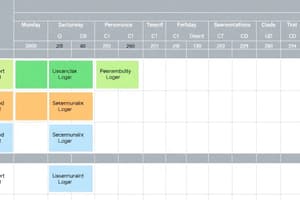Podcast
Questions and Answers
What is considered a major challenge for project managers regarding project delivery?
What is considered a major challenge for project managers regarding project delivery?
- Delivering projects on time (correct)
- Securing adequate resources
- Maintaining project budgets
- Managing stakeholder expectations
Which of the following is NOT typically included in a schedule management plan?
Which of the following is NOT typically included in a schedule management plan?
- Risk management plan (correct)
- Milestone list
- Activity list
- Project schedule network diagram
What does timeboxing refer to in agile project management?
What does timeboxing refer to in agile project management?
- Setting fixed time periods for completing tasks (correct)
- Scheduling activities in a network diagram
- An estimation technique for task duration
- Allocating resources based on priority
How does the critical path affect project completion?
How does the critical path affect project completion?
Which of these methods is part of agile/hybrid project schedule management?
Which of these methods is part of agile/hybrid project schedule management?
Why might schedule conflicts arise during a project?
Why might schedule conflicts arise during a project?
What does a project schedule network diagram illustrate?
What does a project schedule network diagram illustrate?
Which of the following best describes critical chain scheduling?
Which of the following best describes critical chain scheduling?
What is the main purpose of using effort in project management?
What is the main purpose of using effort in project management?
Which of the following statements about effort and duration is true?
Which of the following statements about effort and duration is true?
What information does a three-point estimate include?
What information does a three-point estimate include?
What is the main output of the project schedule development process?
What is the main output of the project schedule development process?
Which technique is used in PERT for estimating project duration?
Which technique is used in PERT for estimating project duration?
Which of the following is NOT a tool or technique for schedule development?
Which of the following is NOT a tool or technique for schedule development?
What is the first step in calculating the critical path?
What is the first step in calculating the critical path?
Why are three-point estimates particularly useful in project management?
Why are three-point estimates particularly useful in project management?
How should estimates for tasks be created in project management?
How should estimates for tasks be created in project management?
What factor determines the critical path in a project?
What factor determines the critical path in a project?
If an activity on the critical path takes longer than planned, what happens?
If an activity on the critical path takes longer than planned, what happens?
How many critical paths can exist in a project?
How many critical paths can exist in a project?
Why is it important for a project manager to know the critical path throughout the project?
Why is it important for a project manager to know the critical path throughout the project?
What unique practice did a project team at Apple employ regarding the critical task?
What unique practice did a project team at Apple employ regarding the critical task?
What example illustrates that not all activities related to the critical path are necessarily critical in function?
What example illustrates that not all activities related to the critical path are necessarily critical in function?
What happens to the critical path as a project progresses?
What happens to the critical path as a project progresses?
What does critical chain scheduling prioritize in project management?
What does critical chain scheduling prioritize in project management?
What is the primary purpose of a project buffer in critical chain scheduling?
What is the primary purpose of a project buffer in critical chain scheduling?
Which law states that 'work expands to fill the time allowed'?
Which law states that 'work expands to fill the time allowed'?
In agile project management, what is the term used for focusing on the most valuable work within each iteration?
In agile project management, what is the term used for focusing on the most valuable work within each iteration?
What does critical chain scheduling aim to minimize in resource management?
What does critical chain scheduling aim to minimize in resource management?
What type of buffer is added before tasks on the critical path in critical chain scheduling?
What type of buffer is added before tasks on the critical path in critical chain scheduling?
How do traditional project scheduling methods differ from critical chain scheduling regarding buffers?
How do traditional project scheduling methods differ from critical chain scheduling regarding buffers?
Which method do some agile teams use for scheduling that emphasizes visual management?
Which method do some agile teams use for scheduling that emphasizes visual management?
What is the purpose of identifying the critical path in project management?
What is the purpose of identifying the critical path in project management?
What does the term 'free slack' or 'free float' refer to in project scheduling?
What does the term 'free slack' or 'free float' refer to in project scheduling?
Which technique involves performing activities in parallel instead of sequence?
Which technique involves performing activities in parallel instead of sequence?
Why is it important to update critical path data during a project's lifecycle?
Why is it important to update critical path data during a project's lifecycle?
What does total slack or total float indicate in project scheduling?
What does total slack or total float indicate in project scheduling?
What should a project manager do if the project's completion date will slip?
What should a project manager do if the project's completion date will slip?
In the context of critical chain scheduling, what does 'the weakest link' refer to?
In the context of critical chain scheduling, what does 'the weakest link' refer to?
What is one of the outcomes of crashing activities in a project schedule?
What is one of the outcomes of crashing activities in a project schedule?
Flashcards are hidden until you start studying
Study Notes
Project Schedule Management
- Delivering projects on time is one of the biggest challenges for managers.
- Time has the least flexibility and continues to pass regardless of project progress.
- Schedule issues are the most common reason for conflicts on projects.
- The second half of a project is particularly susceptible to schedule conflicts.
Importance of Project Schedules
- Individual work styles and cultural differences can cause schedule conflicts.
- The Meyers-Briggs Type Indicator helps assess individuals' attitudes toward structure and deadlines.
- Some prefer following schedules and meeting deadlines, while others do not.
- Effort refers to the number of workdays or work hours needed to complete a task.
- Effort does not usually equal duration.
- Individuals performing the work should participate in creating estimates, and experts should review them.
Three-Point Estimate
- Instead of providing a discrete number for activity estimates, a three-point estimate is often more helpful.
- This estimate includes optimistic, most likely, and pessimistic estimates.
- Three-point estimates are needed for PERT and Monte Carlo simulations.
Program Evaluation Review Technique (PERT)
- PERT is a network analysis technique used to estimate project duration when there is uncertainty about individual activity durations.
- PERT uses probabilistic time estimates, which are based on optimistic, most likely, and pessimistic estimates (three-point estimate).
Developing the Project Schedule
- Schedule development utilizes results from other time management processes to determine project start and end dates.
- The main output of the schedule development process is the project schedule, often displayed using a Gantt chart.
- Important tools and techniques include Gantt charts, critical path analysis, and critical chain scheduling.
Calculating the Critical Path
- First, a comprehensive network diagram is developed.
- Duration estimates for all activities on each path in the network diagram are added.
- The longest path identifies the critical path.
- If any activity on the critical path takes longer than planned, the entire project schedule will slip unless corrective action is taken.
More on the Critical Path
- There may be more than one critical path if multiple paths have the same length.
- The critical path can change as the project progresses.
Critical Path Analysis for Schedule Trade-offs
- Understanding the critical path throughout the project allows project managers to make informed trade-offs.
- This proactive approach helps manage the project schedule.
- Critical path knowledge allows for the application of schedule compression techniques to shorten the project schedule.
- Crashing activities involves finding the greatest amount of schedule compression for the least incremental cost.
- Fast tracking allows activities normally done sequentially to be performed in parallel.
Free and Total Slack
- Free slack (free float) is the time an activity can be delayed without delaying the early start of subsequent activities.
- Total slack (total float) is the time an activity can be delayed without impacting the planned project finish date.
- A forward pass through the network diagram determines the early start and finish dates.
- A backward pass determines the late start and finish dates.
Importance of Critical Path Data Updates
- Updating project schedule information is crucial for meeting time goals.
- The critical path may change as actual start and finish dates are entered.
- If a project completion date slip is anticipated, negotiations with the project sponsor should be initiated.
Critical Chain Scheduling
- The Theory of Constraints emphasizes the limitations of complex systems, often due to a single constraint.
- To improve a system, the constraint must be identified and managed.
- Critical chain scheduling considers limited resources when developing a project schedule and incorporates buffers to protect the project completion date.
- The goal is to minimize multitasking, where a resource works on multiple tasks simultaneously.
Buffers and Critical Chain
- A buffer is additional time allocated to complete a task.
- Murphy’s Law states that if something can go wrong, it will.
- Parkinson’s Law states that work expands to fill the time allowed.
- Traditional estimates often include a buffer for each task, which may or may not be used.
- Critical chain scheduling removes buffers from individual tasks and creates:
- A project buffer: additional time added before the project's due date.
- Feeding buffers: additional time added before tasks on the critical path.
Schedule Planning for Agile Projects
- Agile teams focus on completing the most valuable work within each iteration, instead of creating a detailed schedule for all activities.
- This approach is called time-boxing.
- Some agile teams also use the Kanban method for project scheduling.
Studying That Suits You
Use AI to generate personalized quizzes and flashcards to suit your learning preferences.




